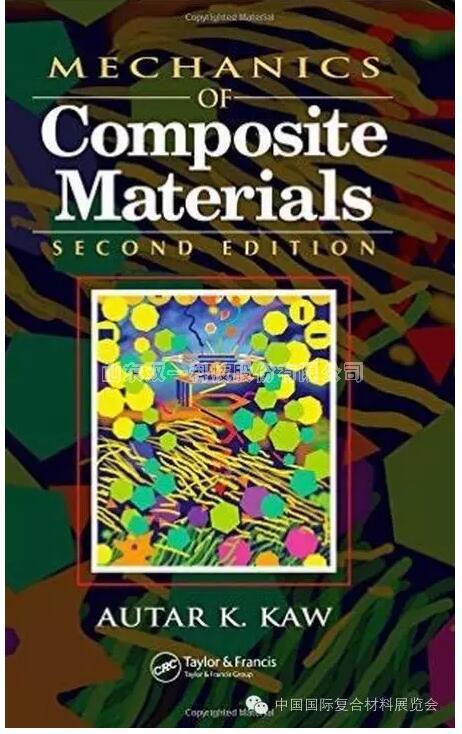
第二版前言
本书的第一版于1997年出版,感谢读者关于本书第一版及其附带软件PROMAL的反馈和建议。本书的修订主要基于课程中使用本书或用本书自学的学生的评论。
在此版本中,增加了关于对称和非对称层合梁的章节。保持原版风格的同时,对其他的章节作了修订。在每章的结尾处新增了关键词和总结,增加了用于强化每章学习的习题,这些都可以在以下教材网址上获得。(http://www.eng.usf.edu/~kaw/promal/book.html)
具体来说,在第1章中,增加了复合材料的新应用。随着网络的发展,文章,视频和相关网址都被上传到了教材网站上。在第2章中,增补了更多的例子和推导过程,也扩充了矩阵代数的附录,这主要是由于一些工程部门不再单独教授矩阵代数这门课程。如果读者需要了解更多相关知识,他(她)可以在http://numericalmethods.eng.usf.edu/上下载矩阵代数的免费电子图书(点击“矩阵代数”)。在第3章中,给出了确定四个弹性模型的弹性常数的方法。在第5章中,增补了两个例子:压力容器和传动轴的设计。
在第3章中,为了增加弹性模型,更新了PROMAL程序。购书者仅可通过教科书网站获得PROMAL及其附带的软件(见“关于软件”部分)。该软件和手册将不断更新。
第一版前言
由于复合材料具有诸如轻质,耐腐蚀,抗疲劳,易装配等优点,其日益成为当今材料的重要组成部分。复合材料在飞机结构、高尔夫球杆、电子包装、医疗设备、空间飞行器及建筑领域得到应用。世界各地的学生对复合材料产生了好奇心和兴趣。他们看到了复合材料在市场上的日益兴起、及这一领域就业机会的增加。美国政府的技术转让计划开启了先进复合材料新的和大规模的应用。
许多工程学院把复合材料课程作为本科技术选修课和研究生课程。此外,作为继续教育和再培训的一部分,许多工程师参与复合材料领域的研讨会及短期的课程。本书的目的是向高年级本科生或研究生水平的学生介绍复合材料的力学性能。但是想在一本书中覆盖复合材料力学性能的所有方面是不可能做到的;而且许多方面涉及到高级研究生学习的知识,如弹性,断裂力学和板壳理论。因此,本书强调复合材料的概述,其次是复合材料的基本力学性能。只有这样,学生才能为深入的课题研究打下一个必要的基础,如冲击,疲劳,断裂力学,蠕变,屈曲和振动等。笔者认为这些课题是重要的,对于有兴趣的学生有很多好的文章可以参考。
本书打破了其他教科书中关于复合材料的传统规则。例如,在第一章中,以一问一答的形式介绍了复合材料。这些问题的提出是根据笔者第一次学习复合材料课程时自己的思维过程,然后还有笔者在南佛罗里达大学(坦帕)的学生的想法。此外,这是本领域内第一本包括专业软件包的教科书。而且,本书风格与其它优秀的本科书籍类似,如:简短的章节,充实的插图,客观问题和数值问题的习题集,必要的评论,简洁的语言,和丰富的例子。
第1章 介绍了复合材料的基本概念,包括为什么复合材料在当今市场上变得越来越重要。第1章中的其他内容包括纤维和基体的类型,制造,应用,回收和复合材料力学中的基本定义。在第2章中,首先介绍了应力、应变、弹性模量和应变能的基本内容。然后讨论了单层板的力学性能,包括单层板的应力-应变关系、刚度和强度、以及应力-应变的湿热响应。在第3章中,笔者从复合材料的成分(连续纤维和基体)的各个性质出发,阐述了单层板的力学性能的方程,例如刚度,强度和热湿膨胀系数。介绍了单层板力学性能的实验表征。第4章是第2章的延伸,本章从宏观力学角度把单层板扩展到层合板。基于单层板的性能,阐述了层合板的应力-应变方程。本章最后讨论了层合板的刚度和强度、以及温度和水分对层合板中残余应力的影响。在第5章中,介绍了市场上使用的特殊层合板,同时开发了层合板失效分析和设计的程序。对其他结构设计问题,如疲劳,环境影响和冲击也进行了介绍。
书中还有一个章节单独介绍用户友好型软件PROMAL,它用来补充对第2章至第5章的理解。学生通过使用PROMAL可以方便地进行实用的参数研究,通过比较失效理论,可以很快从表和曲线中提取有用的信息。
国内计算机实验室的普及,允许教师使用PROMAL作为一个教学工具。学生提出的许多问题可以很快得到回答。PROMAL不仅仅是一个黑盒子,因为它也可以显示中间结果。在课程结束时,它将允许学生在课堂上设计层合板结构。这个计算机程序能满足参数优化的设计要求。
你会发现这本书和软件非常有趣。我欢迎您对本书和软件提出意见、建议和想法,电子邮件:promal@eng.usf.edu; 和URL:http://www.eng.usf.edu/~kaw/ promal / book.html。
目录
1 Introduction to Composite Materials
Chapter Objectives
1.1Introduction
1.2 Classification
1.2.1 Polymer Matrix Composites
1.2.2 Metal Matrix Composites
1.2.3 Ceramic Matrix Composites
1.2.4 Carbon–Carbon Composites
1.3 Recycling Fiber-Reinforced Composites
1.4 Mechanics Terminology
1.5 Summary
Key Terms
Exercise Set
References
General References
Video References
2Macromechanical Analysis of a Lamina
Chapter Objectives
2.1 Introduction
2.2 Review of Definitions
2.2.1 Stress
2.2.2 Strain
2.2.3 Elastic Moduli
2.2.4 Strain Energy
2.3 Hooke’s Law for Different Types of Materials
2.3.1 Anisotropic Material
2.3.2 Monoclinic Material
2.3.3 Orthotropic Material (Orthogonally Anisotropic)/Specially Orthotropic
2.3.4 Transversely Isotropic Material
2.3.5 Isotropic Material
2.4 Hooke’s Law for a Two-Dimensional Unidirectional Lamina
2.4.1 Plane Stress Assumption
2.4.2 Reduction of Hooke’s Law in Three Dimensions to Two Dimensions
2.4.3 Relationship of Compliance and Stiffness Matrix to Engineering Elastic Constants of a Lamina
2.5 Hooke’s Law for a Two-Dimensional Angle Lamina
2.6 Engineering Constants of an Angle Lamina..2.7 Invariant Form of Stiffness and Compliance Matrices for an Angle Lamina
2.8 Strength Failure Theories of an Angle Lamina
2.8.1 Maximum Stress Failure Theory
2.8.2 Strength Ratio
2.8.3 Failure Envelopes
2.8.4 Maximum Strain Failure Theory
2.8.5 Tsai–Hill Failure Theory
2.8.6 Tsai–Wu Failure Theory
2.8.7 Comparison of Experimental Results with Failure Theories
2.9 Hygrothermal Stresses and Strains in a Lamina
2.9.1 Hygrothermal Stress–Strain Relationships for a Unidirectional Lamina
2.9.2 Hygrothermal Stress–Strain Relationships for an Angle Lamina
2.10 Summary
Key Terms
Exercise Set
References
Appendix A: Matrix Algebra
Key Terms
Appendix B: Transformation of Stresses and Strains
B.1 Transformation of Stress
B.2 Transformation of Strains
Key Terms
3 Micromechanical Analysis of a Lamina
Chapter Objectives
3.1 Introduction
3.2 Volume and Mass Fractions, Density, and Void Content
3.2.1 Volume Fractions
3.2.2 Mass Fractions
3.2.3 Density
3.2.4 Void Content
3.3 Evaluation of the Four Elastic Moduli
3.3.1 Strength of Materials Approach
3.3.1.1 Longitudinal Young’s Modulus
3.3.1.2 Transverse Young’s Modulus
3.3.1.3 Major Poisson’s Ratio
3.3.1.4 In-Plane Shear Modulus
3.3.2 Semi-Empirical Models
3.3.2.1 Longitudinal Young’s Modulus
3.3.2.2 Transverse Young’s Modulus
3.3.2.3 Major Poisson’s Ratio
3.3.2.4 In-Plane Shear Modulus
3.3.3 Elasticity Approach
3.3.3.1 Longitudinal Young’s Modulus
3.3.3.2 Major Poisson’s Ratio
3.3.3.3 Transverse Young’s Modulus
3.3.3.4 Axial Shear Modulus
3.3.4 Elastic Moduli of Lamina with Transversely Isotropic Fibers
3.4 Ultimate Strengths of a Unidirectional Lamina
3.4.1 Longitudinal Tensile Strength
3.4.2 Longitudinal Compressive Strength
3.4.3 Transverse Tensile Strength
3.4.4 Transverse Compressive Strength
3.4.5 In-Plane Shear Strength
3.5 Coefficients of Thermal Expansion
3.5.1 Longitudinal Thermal Expansion Coefficient
3.5.2 Transverse Thermal Expansion Coefficient
3.6 Coefficients of Moisture Expansion
3.7 Summary
Key Terms
Exercise Set
References
4 Macromechanical Analysis of Laminates
Chapter Objectives
4.1 Introduction
4.2 Laminate Code
4.3 Stress–Strain Relations for a Laminate
4.3.1 One–Dimensional Isotropic Beam Stress–Strain Relation
4.3.2 Strain-Displacement Equations
4.3.3 Strain and Stress in a Laminate
4.3.4 Force and Moment Resultants Related to Midplane Strains and Curvatures
4.4 In-Plane and Flexural Modulus of a Laminate
4.4.1 In-Plane Engineering Constants of a Laminate
4.4.2 Flexural Engineering Constants of a Laminate
4.5 Hygrothermal Effects in a Laminate
4.5.1 Hygrothermal Stresses and Strains
4.5.2 Coefficients of Thermal and Moisture Expansion of Laminates
4.5.3 Warpage of Laminates
4.6 Summary
Key Terms
Exercise Set
References
5 Failure, Analysis, and Design of Laminates
Chapter Objectives
5.1 Introduction
5.2 Special Cases of Laminates
5.2.1 Symmetric Laminates
5.2.2 Cross-Ply Laminates
5.2.3 Angle Ply Laminates
5.2.4 Antisymmetric Laminates
5.2.5 Balanced Laminate
5.2.6 Quasi-Isotropic Laminates
5.3 Failure Criterion for a Laminate
5.4 Design of a Laminated Composite
5.5 Other Mechanical Design Issues
5.5.1 Sandwich Composites
5.5.2 Long-Term Environmental Effects
5.5.3 Interlaminar Stresses
5.5.4 Impact Resistance
5.5.5 Fracture Resistance
5.5.6 Fatigue Resistance
5.6 Summary
Key Terms
Exercise Set
References
6 Bending of Beams
Chapter Objectives
6.1 Introduction
6.2 Symmetric Beams
6.3 Nonsymmetric Beams
6.4 Summary
Key Terms
Exercise Set
References
来源:武汉理工王继辉教授课题组